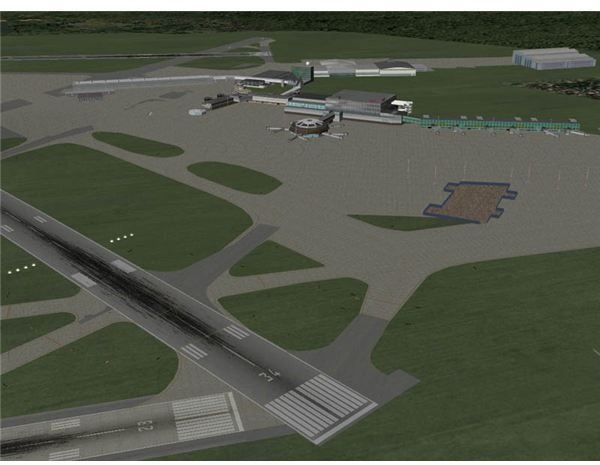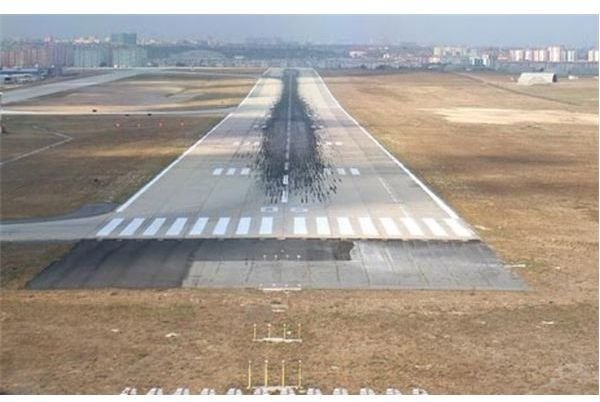Airplane Runways and Taxiways
Introduction
With a highly demanding and frenzied lifestyle, air travel has become a regular affair for most of us these days. People chose airplanes to travel internationally when it became almost indispensable to do so. With the changing times and because of time constraints, people started using air travel for domestic destinations as well. However, many amongst them also enjoy the thrill factor when the planes take off or land and there are those who panic during the same. But how much do they really know about airplane runways or taxiways?
Image Credits : Runway from wired website (https://www.wired.com/images_blogs/autopia/images/2008/08/08/runway_2.jpg)
Runways and Taxiways
Airplane runway has much more to it beyond its simple definition - a strip of land used by the airplanes for taking off and landing. An airplane runway (generally white in color) lets the pilot maneuver the plane as desired without any damage to the aircraft and the surrounding area. It is also where the airplanes usually move at a faster pace to get the desired momentum for the airplane to take-off.
Unlike airplanes, taxiways link the runways, ramps, hangers, terminals with numerous other facilities. Moreover, they permit the airplanes to fly quickly and vacate the premise for another aircraft. Some of the most commonly known type of taxiway is the parallel taxiway, which is generally narrower than the conventional runways. Taxiways make use of alphabet markings and the airplanes usually accelerate or decelerate at a slower pace on them.

Image Credits : Taxiways connecting runway from x-plane forum website (https://homepage.mac.com/cormacshaw/xpih/scenery/dublin_r26/pics/large/05.jpg )
Understanding Runways and Taxiways : Different Types
Originally, pilots used open stretches such as farms or fields, which performed the purpose of runways. However, both landing and take-off operations were restricted at night to avoid accidents. Then, in the late 1920s rotating lights were positioned along the landing field so as to locate the landing area or the runway at night from the airplane. The Cleveland Municipal Airport in the United States was the first airport which introduced runway lighting in 1930. Moreover, the Dallas Love Field Airport is also reported to be one of the oldest runways using the technology in the United States.
Technically, there are mainly two types of airplane runways: the visual and instrument. The instrument airplane runway involves a ground based approach whereby exact instructions are given to an aircraft using radio signals and high intensity lighting arrays so that the airplane could have a safe landing especially in situations of low ceilings or less visibility owing to fog, blowing snow or rain. The visual airplane runway on the other hand uses minimal instrument approach. In this case, the pilot needs to have a visual reference of the runway for landing an airplane. For this, there are retro-reflective panels comprising of pairs of color-coded orange panel markers pointing towards the touchdown zone.
Coming to taxiways, there are six main different types of taxiways which include runway, parking, taxi, path, closed and vehicle. The runway taxiway is positioned in the center of a runway. A parking taxiway links the regular taxiway to the parking premise. A basic taxiway is the major track used for taxing at airports. Path taxiways are more popular at smaller airports, especially those having grass runways. Closed taxiways with an ‘X’ marking allow the air traffic control to make use of the signal. Finally, the vehicle taxiway ensures precise supervision for air traffic. Busy airports also have high-speed or rapid exit taxiways to clear the premise for other aircrafts.

Image Credits : Runway at night from binrock website (https://binrock.net/permanent/2007/0629_night_flying/runway_lighting.jpg )
Construction Details
The runway surfaces are generally made using various materials such as gravel, sod, dirt, concrete, asphalt and water. Usually, the runways are at least 6,000 feet in length with an aircraft capacity of less than 90,178 kg. Runways are constructed using various markings which define runway, runway designation, threshold, centerline, touchdown zone, aiming point, displaced threshold, runway side stripe, runway demarcation bar, chevron markings for blast pads and stop ways and those for closure.
Taxiways are built using materials such as asphalt and concrete, and at smaller airports they are even made using gravel or grass. While constructing a taxiway, the navigation lights are placed 75 feet apart and at some airports, the lights are placed nearer at the intersections. Taxiways involve a series of markings for centerline, taxiway edge, runway holding position, ILS (Instrument Landing System) and Critical area holding position.
Nevertheless, there are various parameters that are also to be considered before designing an airplane runway such as the performance requirements imposed by FAR regulations, environmental characteristics and operating limits on aircraft weight. Interestingly, world records claim the airports of Qamdo Bangda and Ramenskoye to have the longest runways.
